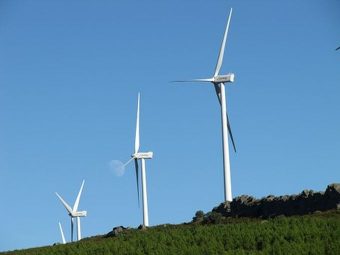
China has been building two wind turbines every hour, the International Energy Agency (IEA) has told BBC News.
This is the world’s biggest programme of turbine installation, double that of its nearest rival, the US.
The nation’s entire annual increase in energy demand has been fulfilled from the wind.
But the IEA warns China has built so much coal-fired generating capacity that it is turning off wind turbines for 15% of the time.
The problem is that coal-fired power stations are given priority access to the grid.
An IEA spokesman told BBC News: “The rather rosy statement on wind energy hides the issue that 2015 and the first half of 2016 also saw record new installations of coal.
“China has now a clear over-supply. In the province of Gansu, 39% of wind energy had to be curtailed (turned off because there is not enough capacity on the grid).
The average European wind farm is forced to stop generating between 1-2% of the year.
‘Unsustainable’ position
He said: “China’s position is clearly unsustainable. It will need strong policy decisions, including the construction of many more grid lines and a phase-out policy for older, more inefficient coal power plants.”
State media has reported China’s plans to impose a moratorium on all new coal-fired plants until 2018.
The IEA says China installed more than 30,000 MW of new wind energy in 2015 – partly thanks to a rush driven by the Chinese government making its existing subsidies less attractive.
Construction has slackened in 2016, but only to a level of more than one turbine per hour.
Steve Sawyer from the Global Wind Energy Council told BBC News: “China’s build up of its capacity in wind – and now solar – is truly without parallel.
“It is no surprise that the Chinese grid’s capability to integrate this variable renewable energy has not progressed at the same rate, but to change this situation China needs to rapidly progress with electricity market reform.”
China has a recent history of setting targets on energy and climate change that it is sure it can achieve.
The government apparently over-estimated the likely increase of electricity demand, which grew just 0.5% – as China’s growth slowed, and dirty industries either closed down or improved energy efficiency.
It’s this decrease in demand and increase in renewables that gave China the confidence to ratify the Paris climate change agreement last week.
Lu Kang, China’s Foreign Ministry spokesman, told BBC News: “China has made great efforts in areas including reducing emission, environmental protection and developing renewable sustainable energy.
“The International Community recognises our leading example role on climate change. I can assure you that China is determined to stick to this green sustainable path of development. This also serves China’s own need for development.”
Complicated transition
Lauri Myllyvirta of Greenpeace China told BBC News: “China has a coal bubble: it already has more coal-fired generation than it needs yet it is still building one power station a week.
“This complicates the transition to clean energy because companies are unhappy because they can’t run their power stations as much as they expected – they are sitting idle for much of the time.
“It is also a massive waste of resources that could be spent on clean energy instead.”
The IEA says the boom in coal-plant building has been spurred by readily-available finance and help from local authorities. Mining and transport companies are diversifying into power plant construction.
In its first global review of energy investment, the IEA says the energy system is broadly turning towards low-carbon energy and energy efficiency – but investment in key clean energy technologies needs to triple to meet the climate targets agreed at the Paris climate summit.
Source: bbc.com

